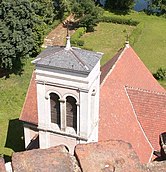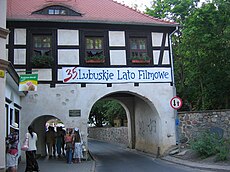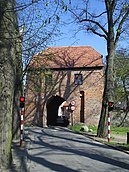Łagów (Powiat Świebodziński)
| Łagów | ||
|---|---|---|
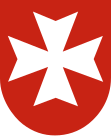
|
|
|
| Basic data | ||
| State : | Poland | |
| Voivodeship : | Lebus | |
| Powiat : | Świebodzin | |
| Geographic location : | 52 ° 20 ' N , 15 ° 18' E | |
| Residents : | 1588 (March 31, 2011) | |
| Postal code : | 66-220 | |
| Telephone code : | (+48) 68 | |
| License plate : | FSW | |
| Gmina | ||
| Gminatype: | Rural community | |
| Gmina structure: | 11 school offices | |
| Surface: | 199.19 km² | |
| Residents: | 4969 (June 30, 2019) |
|
| Population density : | 25 inhabitants / km² | |
| Community number ( GUS ): | 0808022 | |
| Administration (as of 2015) | ||
| Community leader : | Czesław Kalbarczyk | |
| Address: | ul. 1 Lutego 7 66-220 Łagów |
|
| Website : | www.lagow.pl | |
Łagów ( German Lagow ) is a village with a small town character in the Polish Lubusz Voivodeship , Powiat Świebodziński (Schwiebus District) . The village is the seat of a rural community of the same name.
Geographical location
The village is located on the river Pliszka ( Pleiske ) in the former state of Sternberg (Ziemia Torzymska ) , the southern part of the Neumark north of the European route from Frankfurt (Oder) to Świebodzin (Schwiebus) . The distance to Frankfurt is about 45 kilometers, to Schwiebus about 25 kilometers. Lagow is located in the middle of the Lagow landscape protection park .
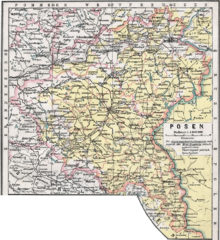
history
The Falkenberg, located near the town, was already settled in the Bronze Age ( Lausitz culture ). There was a Slavic castle in the same place in the 11th and 12th centuries. In 1251 the area came under German rule. In 1258, Lagow Castle came into the possession of Margrave Johann I ; in the following decades it was controversial between the bishops of Lebus , the Brandenburg margraves and the archbishops of Magdeburg.
Lagow was first mentioned in 1299 when the Brandenburg margraves Otto IV and Heinrich II transferred the castle to the knight Albrecht von Klepitz. The facility at that time was about 500 m northwest of the Johanniterburg, which still exists today, on the Falkenberg. The place belonged to the Brandenburg state of Sternberg, which was first mentioned in 1313 under this name.
Mid-14th century was Castle Lagow with the hanging thereon feudal privileges in the possession of the Order of St. John about that began after a short time to build a new castle on a hill between the Tschetschsee ( Polish Ciecz in) in the north and the Lagowsee South on a narrow isthmus.
At the foot of the Citadel an associated settlement for craftsmen and vassals, with defensive walls and two gates, Märkisches today Tor (originated polish Brama Marchijska ) and Polish Gate ( Polish Brama Polska was) called secured. At the end of the 14th century, a Hospitaller Commandery was set up at the castle , which belonged to the Sonnenburg Lordship . Lagow was one of the largest commanderies of the Order of St. John. From 1535 to 1571 Lagow belonged to Brandenburg-Küstrin , but then fell back to Kurbrandenburg. In 1569 Lagow was given city rights.
As part of Brandenburg Lagow came with this to Brandenburg-Prussia . During the Thirty Years War , Lagow was captured and destroyed by Sweden in 1640 . In 1726 the town charter was renewed; around 1800 the city was the smallest in Prussia for a while . The state of Sternberg became the Sternberg District as part of the division of Brandenburg into districts in 1747. In 1750 the town had 267 inhabitants, in 1850 450 inhabitants, and in 1925 630 inhabitants.
After the dissolution of the Commandery in 1811, Lagow Castle and its lands went into private ownership; feudal privileges were extinguished or terminated by the Edict of October 1807 and the Edict of Regulation of 1811 . With the formation of the districts in Prussia from 1815, Lagow came to the administrative district of Frankfurt as part of the Sternberg district . The town was the seat of a royal chief forester and a rent office . The place developed into a popular summer retreat and climatic health resort with 3000 guests (1929).
Lagow belonged from the division of the Sternberg district from 1873 to 1945 to the Oststernberg district of the province of Brandenburg .
During the fighting towards the end of the Second World War in the spring of 1945, the castle and the village were not destroyed. After the war ended in 1945, Lagow was placed under Polish administration. Polish migrants settled here, some of them from areas east of the Curzon Line , which Poland had conquered after the First World War . The local residents - provided they had not fled - were subsequently evicted by the local Polish administrative authorities . The spelling of the place name of the small German town was changed to Łagów .
The coat of arms carried by the village to this day reminds of the centuries-long presence of the Johanniter in Lagow.
The main occupations of the population are currently agriculture and tourism .
Lagow Castle around 1860, Alexander Duncker collection
Annual population before 1945
- 1732: 201
- 1750: 267
- 1801: 319
- 1840: 388
- 1855: 586, including three Catholics and nine Jews
- 1933: 1.093
- 1939: 1.155
Owner of Castle and Gut Lagow
Owners of Castle and Gut Lagow from 1350 to 1945:
- 1350-1810: Order of St. John
- 1810–1818: Prussian State Domain
- 1819–1830: August Friedrich Wilhelm Franz von Zastrow
- 1834–1843: Franz Wilhelm von Barfus-Falkenberg
- 1843–1852: Hermann von Oppen from the Groß-Gandern house
- 1852–1856: von Arnim family
- 1856–1893: Count Hugo Wrschowetz Sekerka von Sedcziz
- 1893–1945: Baroness Wurmb von Zink , b. by Wylich and Lottum
Municipality (Gmina Łagów)
The rural community (gmina wiejska) Łagów has about 5,000 inhabitants. The following localities (German names until 1945) with Schulzenamt (sołectwo) belong to it :
Other localities in the municipality without the Schulzenamt are:
- Brzezinki
- Czartów (Schartowsthal)
- Cyst (Grunewald)
- Gronów-Winiarnia
- Jemiołów (gajówka) (Petersdorf)
- Kosobudki (New Kunersdorf)
- Pasałka
- Sieniawa-Kopalnia (Schönow)
- Stok (stick)
- Troszki (Kunersdorfer Sorge)
- Targets
- Zamęt (Neumühl)
Culture
Since the late 1960s, the Lubuskie Lato Filmowe (Lubuskie Film Summer) , the oldest Polish feature film festival , has been held in Łagów every year on midsummer night .
sons and daughters of the town
- Walter Prüschenk von Lindenhofen (1857–1916), member of the Reichstag
- Gerhard Domagk (1895–1964), German bacteriologist and Nobel Prize winner
literature
- Heinrich Berghaus : Land book of the Mark Brandenburg and the Margraviate Nieder-Lausitz in the middle of the 19th century . Volume 3, 1st edition, Brandenburg 1856, pp. 254-255 ( online ) and pp. 286-287 ( online ).
- W. Riehl, J. Scheu (Hrsg.): Berlin and the Mark Brandenburg with the Margraviate Nieder-Lausitz in their history and in their present existence . Berlin 1861, pp. 483-484.
- Wilhelm von Obernitz: 700 years of Lagow. 200 years of the city: Festschrift for the 700th anniversary and the 200th anniversary of the city on July 10, 1927. Ed .: Magistrat der Stadt Lagow. Trowitzsch, Frankfurt / Oder 1927.
- Eduard Ludwig Wedekind : Sternbergische Kreis-Chronik. History of the cities, towns, villages, colonies, castles etc. of this part of the country from the earliest past to the present . Zielenzig 1855, p. 209.
- Siegmund Wilhelm Wohlbrück : History of the former diocese of Lebus and the country of this taking . Volume 3, Berlin 1832, pp. 512-515.
Web links
- Lagow website (Polish)
- Website of the Lagowski Landscape Protection Park (Łagowski Park Krajobrazowy) (Polish)
- Website of Lebuser film summer (Polish)
Footnotes
- ^ CIS 2011: Ludność w miejscowościach statystycznych według ekonomicznych grup wieku (Polish), March 31, 2011, accessed on July 4, 2017
- ↑ population. Size and Structure by Territorial Division. As of June 30, 2019. Główny Urząd Statystyczny (GUS) (PDF files; 0.99 MiB), accessed December 24, 2019 .
- ^ Website of the municipality, Wójt Gminy Łagów , accessed on February 26, 2015
- ↑ a b c d e f W. Riehl, J. Scheu (ed.): Berlin and the Mark Brandenburg with the Margraviate of Nieder-Lausitz in their history and in their current existence . Berlin 1861, pp. 483-484.
- ↑ a b c Lagow. In: The Great Brockhaus. 15th edition. 1928-1935, Vol. 12 L to Mah (1932), p. 37.
- ↑ Lagow. In: Meyers Konversations-Lexikon. 6th edition. 1902-1908, Vol. 12 L to Lyra (1906), p. 53.
- ↑ Johann Gottfried Dienemann, Johann Erdmann Hasse: News from the Order of St. John, in particular from its lordship in the Mark, Saxony, Pomerania and Wendland . Berlin 1767, p. 86.
- ^ A b c Eduard Ludwig Wedekind : Sternbergische Kreis-Chronik. History of the cities, towns, villages, colonies, castles etc. of this part of the country from the earliest past to the present . Zielenzig 1855, p. 209.
- ^ A b Michael Rademacher: German administrative history from the unification of the empire in 1871 to the reunification in 1990. Oststernberg.html. (Online material for the dissertation, Osnabrück 2006).
- ↑ Jörg Lüderitz: Discoveries east of the Oder. On the way between Frankfurt, Skwierzyna and Żary. Trescher, Berlin 2005, ISBN 3-89794-082-5 , pp. 80ff. ( Trescher series of trips ; online at Google Book Search ).





